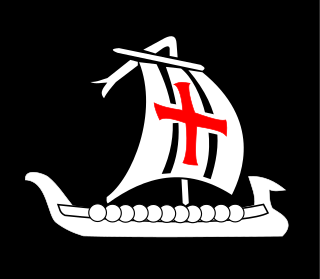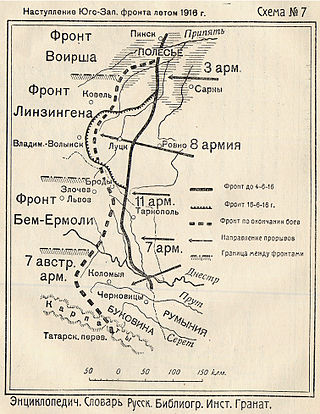
The 10th (Irish) Division, was one of the first of Kitchener's New Army K1 Army Group divisions, authorized on 21 August 1914, after the outbreak of the Great War. It included battalions from the various provinces of Ireland. It was led by Irish General Bryan Mahon and fought at Gallipoli, Salonika and Palestine. It was the first of the Irish Divisions to take to the field and was the most travelled of the Irish formations. The division served as a formation of the United Kingdom's British Army during World War I.

The Allies, or the Entente powers, were an international military coalition of countries led by the French Third Republic, the United Kingdom of Great Britain and Ireland, the Russian Empire, the United States, the Kingdom of Italy, and the Empire of Japan against the Central Powers of the German Empire, the Austro-Hungarian Empire, the Ottoman Empire, and the Kingdom of Bulgaria during the First World War (1914–1918).

The Russian Caucasus Army of World War I was the Russian field army that fought in the Caucasus Campaign and Persian Campaign of World War I. It was renowned for inflicting heavy casualties on the opposing forces of the Ottoman Empire, particularly at the Battle of Sarikamish. It was also known for its extremely diverse ethnic composition, consisting of units from throughout the Russian Empire and both soldiers and officers from the many ethnic communities settled since the 1877-78 Russo-Turkish War in the militarily administered Kars Oblast in the Russian Transcaucasus. These included Georgians, Caucasus Greeks, and Armenians - the latter in particular strongly represented among both the soldiers and senior officers - as well as ethnic Russians and Ukrainians.

V Corps was an army corps of the British Army that saw service in both the First and the Second World Wars. It was first organised in February 1915 and fought through the First World War on the Western front. It was recreated in June 1940, during the Second World War and was substantially reorganised in 1942 for participation in Operation Torch. It fought through the Tunisia Campaign and later the Italian Campaign.

Dmitry Grigoryevich Shcherbachev was a general in the Russian Army during World War I and one of the leaders of the White Movement during the Russian Civil War.

The Russian Third Army was a World War I Russian field army that fought on the Eastern theatre of war.
The 3rd Army Corps was an Army corps in the Imperial Russian Army formed on 19 February 1877.

Vladimir Viktorovich Sakharov was a Russian general of the cavalry who served in the Russian Imperial Army. In an army career lasting from 1869 to 1917, he served in the Russo-Turkish War of 1877-1878, the Russo-Japanese War, and World War I.

The Southwestern Front was an army group of the Imperial Russian Army during World War I. During the conflict it was responsible for managing operations along a front line that stretched 615 kilometers, from what is now southern Belarus to northern Romania, and took part in such operations as the Battle of Galicia and the Brusilov Offensive. It was established in August 1914 and lasted throughout the war until the unrest caused by the Russian Revolution, at which point it was demobilized along with the rest of the Russian Army in early 1918. In total some two million troops had been under its command.

Alexander Frantsevich Ragoza, in Ukrainian Oleksandr Frantsevych Rohoza, was a Minister of Defense of the Ukrainian State. He was also a general of the infantry in the Imperial Russian Army who saw service during World War I.

The 10th Army was a field army of the Imperial Russian Army during the First World War.
The Russian 11th Army was a World War I Russian field army that fought on the Eastern theatre of war.
The Russian 9th Army was a World War I Russian field army that fought on the Eastern theatre of war.
The 1st Don Cossack Division was a Don Cossack cavalry division of the Russian Imperial Army.
Vladimir Vasilyevich Smirnov was an Imperial Russian Army general of the infantry who was a division, corps and field army commander. He fought in the Russian-Turkish War of 1877–1878 and in World War I.

Nikolai Gerasimovich Volodchenko was a Lieutenant-General of the Imperial Russian Army. In 1917, he was the commander-in-chief of the Southwestern front.

Vasily Yegorovich Flug was an Imperial Russian Army General of the Infantry. A career military officer, he served in the Boxer Rebellion, Russo-Japanese War, and World War I, before joining the White movement during the Russian Civil War. Like many other officers, he went into exile after the end of the Russian Civil War, initially moving to Yugoslavia. After World War II, Flug went to the United States, where he died.

Georgy Nikolaevich Viranovsky was a Russian commander, participant in the Russo-Japanese War and World War I, Lieutenant General, and participant in the White Movement during the Civil War (1918-1920). He was Cavalier of the Order of St. George 3rd and 4th degree.

Evgeny Aleksandrovich Radkevich was an Imperial Russian Army general of the infantry and a member of the Russian Empire's Military Council. He saw combat during the Russo-Turkish War of 1877–1878 and the Russo-Japanese War and served as a commander of Russian field armies during World War I.
The 9th Siberian Rifle Division was a military formation of the Imperial Russian Army which participated all major wars of the army in the early 19th century.













